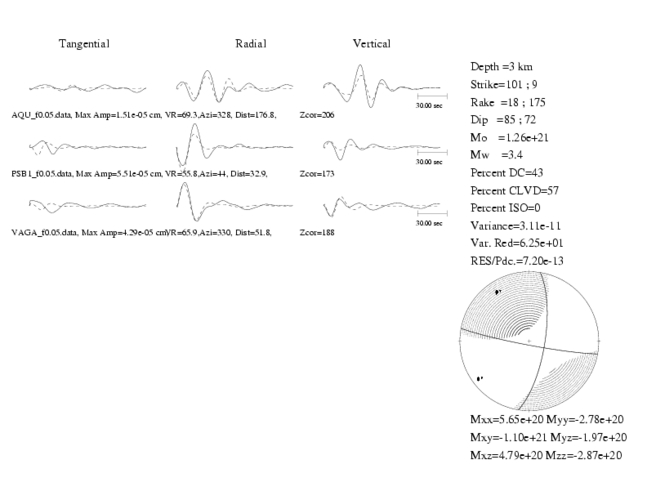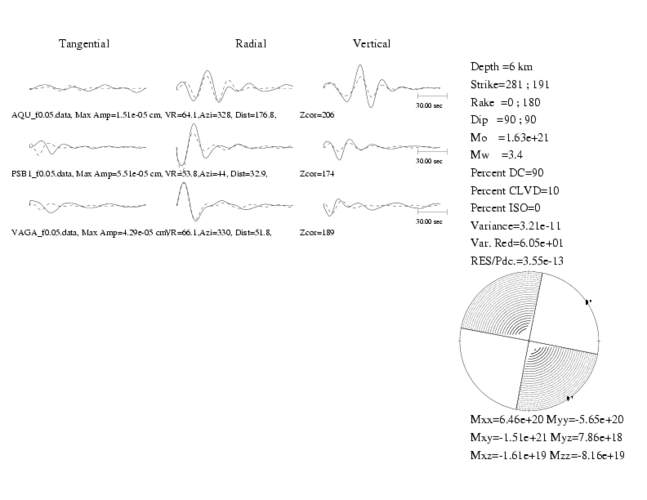Location
2005/05/21 19:55:19 40.99N 14.51E 16 3.7 Italy
Arrival Times (from USGS)
Arrival time list
Felt Map
USGS Felt map for this earthquake
USGS Felt reports page for Intermountain Western US
Focal Mechanism
SLU Moment Tensor Solution
2005/05/21 19:55:19 40.99N 14.51E 16 3.7 Italy
Best Fitting Double Couple
Mo = 2.37e+21 dyne-cm
Mw = 3.55
Z = 2 km
Plane Strike Dip Rake
NP1 100 50 -90
NP2 280 40 -90
Principal Axes:
Axis Value Plunge Azimuth
T 2.37e+21 5 190
N 0.00e+00 -0 280
P -2.37e+21 85 10
Moment Tensor: (dyne-cm)
Component Value
Mxx 2.26e+21
Mxy 3.99e+20
Mxz -4.06e+20
Myy 7.04e+19
Myz -7.15e+19
Mzz -2.34e+21
##############
######################
############################
##############################
#########-----------##############
#####----------------------#########
###----------------------------#######
##--------------------------------######
------------------- --------------####
#------------------- P ----------------###
##------------------ -----------------##
###--------------------------------------#
#####------------------------------------#
######---------------------------------#
#########----------------------------###
############---------------------#####
##################-------###########
##################################
##############################
############################
###### #############
## T #########
Harvard Convention
Moment Tensor:
R T F
-2.34e+21 -4.06e+20 7.15e+19
-4.06e+20 2.26e+21 -3.99e+20
7.15e+19 -3.99e+20 7.04e+19
Details of the solution is found at
http://www.eas.slu.edu/Earthquake_Center/NEW/20050521195519/index.html
|
INGV plot_3_st3.jpg

INGV plot_6_st3_reviewed.jpg

|
The focal mechanism was determined using broadband seismic waveforms. The location of the event and the
station distribution are given in Figure 1.

|
|
Figure 1. Location of broadband stations used to obtain focal mechanism
|
Preferred Solution
The preferred solution from an analysis of the surface-wave spectral amplitude radiation pattern, waveform inversion and first motion observations is
STK = 100
DIP = 50
RAKE = -90
MW = 3.55
HS = 2
The solution given here is from waveform inversion of regional vaeforms from the INGV digital seismic stations.
Waveform Inversion
The program wvfgrd96 was used with good traces observed at short distance to determine the focal mechanism, depth and seismic moment. This technique requires a high quality signal and well determined velocity model for the Green functions. To the extent that these are the quality data, this type of mechanism should be preferred over the radiation pattern technique which requires the separate step of defining the pressure and tension quadrants and the correct strike.
The observed and predicted traces are filtered using the following gsac commands:
hp c 0.02 3
lp c 0.05 3
The results of this grid search from 0.5 to 19 km depth are as follow:
DEPTH STK DIP RAKE MW FIT
WVFGRD96 0.5 270 55 -90 3.48 0.3045
WVFGRD96 1.0 270 50 -90 3.49 0.2888
WVFGRD96 2.0 100 50 -90 3.55 0.3062
WVFGRD96 3.0 285 25 -75 3.63 0.2732
WVFGRD96 4.0 280 20 -80 3.67 0.2862
WVFGRD96 5.0 275 20 -85 3.68 0.2962
WVFGRD96 6.0 95 70 -85 3.68 0.2959
WVFGRD96 7.0 95 70 -85 3.68 0.2902
WVFGRD96 8.0 95 70 -85 3.70 0.2839
WVFGRD96 9.0 95 70 -85 3.69 0.2711
WVFGRD96 10.0 105 75 -75 3.67 0.2585
WVFGRD96 11.0 110 80 -70 3.66 0.2486
WVFGRD96 12.0 300 90 65 3.65 0.2438
WVFGRD96 13.0 310 80 60 3.66 0.2430
WVFGRD96 14.0 315 75 60 3.66 0.2431
WVFGRD96 15.0 315 75 60 3.66 0.2431
WVFGRD96 16.0 320 70 60 3.66 0.2432
WVFGRD96 17.0 325 65 65 3.67 0.2429
WVFGRD96 18.0 325 65 60 3.67 0.2422
WVFGRD96 19.0 320 65 60 3.67 0.1358
WVFGRD96 20.0 320 65 60 3.66 0.1351
WVFGRD96 21.0 320 65 65 3.72 0.2324
WVFGRD96 22.0 325 60 65 3.73 0.2318
WVFGRD96 23.0 325 60 65 3.73 0.2309
WVFGRD96 24.0 335 55 70 3.73 0.2300
WVFGRD96 25.0 330 55 70 3.74 0.2291
WVFGRD96 26.0 330 55 70 3.74 0.2282
WVFGRD96 27.0 330 55 70 3.74 0.2278
WVFGRD96 28.0 340 50 75 3.75 0.2273
WVFGRD96 29.0 335 50 75 3.76 0.2280
WVFGRD96 30.0 335 50 75 3.76 0.2287
The best solution is
WVFGRD96 2.0 100 50 -90 3.55 0.3062
The mechanism correspond to the best fit is

|
|
Figure 1. Waveform inversion focal mechanism
|
The best fit as a function of depth is given in the following figure:

|
|
Figure 2. Depth sensitivity for waveform mechanism
|
The comparison of the observed and predicted waveforms is given in the next figure. The red traces are the observed and the blue are the predicted.
Each observed-predicted componnet is plotted to the same scale and peak amplitudes are indicated by the numbers to the left of each trace. The number in black at the rightr of each predicted traces it the time shift required for maximum correlation between the observed and predicted traces. This time shift is required because the synthetics are not computed at exactly the same distance as the observed and because the velocity model used in the predictions may not be perfect.
A positive time shift indicates that the prediction is too fast and should be delayed to match the observed trace (shift to the right in this figure). A negative value indicates that the prediction is too slow.
The bandpass filter used in the processing and for the display was
hp c 0.02 3
lp c 0.05 3

|
|
Figure 3. Waveform comparison for depth of 8 km
|

|
|
Focal mechanism sensitivity at the preferred depth. The red color indicates a very good fit to thewavefroms.
Each solution is plotted as a vector at a given value of strike and dip with the angle of the vector representing the rake angle, measured, with respect to the upward vertical (N) in the figure.
|
First motion data
The P-wave first motion data for focal mechanism studies are as follow:
Sta Az(deg) Dist(km) First motion
PSB1 43 36 eP_+
MRB1 68 40 iP_C
SACR 19 48 eP_X
VAGA 333 53 iP_D
SNAL 97 58 iP_C
BSSO 6 62 iP_D
MIDA 343 76 eP_-
CII 348 83 eP_+
RNI2 339 85 eP_-
MRLC 107 86 eP_X
TRIV 2 86 eP_X
FRES 6 110 eP_X
INTR 336 125 eP_X
CUC 135 156 eP_+
CERT 310 167 iP_D
AQU 329 178 eP_X
FIAM 321 184 eP_D
TERO 338 197 iP_D
TOLF 300 242 eP_X
TIP 136 277 eP_X
CING 338 287 eP_+
SACS 315 299 eP_X
MURB 327 302 eP_X
CEL 158 325 eP_X
ARCI 310 327 eP_X
Quality control
The follwoing stations were not used because of excessive low frequency noise in the deconvolved waveforms:
AMUR,
GIUL,
RNI2,
SNAL,
TRIV
Last Changed 2005/05/21






